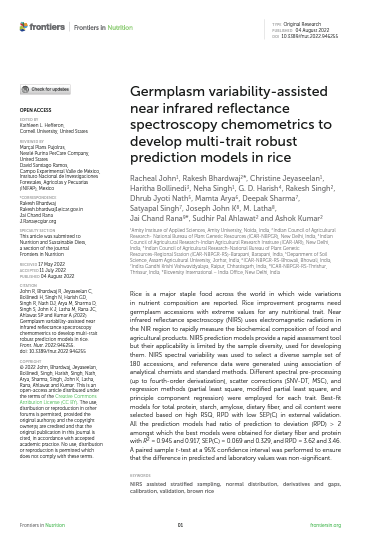Rice is a major staple food across the world in which wide variations in nutrient composition are reported. Rice improvement programs need germplasm accessions with extreme values for any nutritional trait. Near infrared reflectance spectroscopy (NIRS) uses electromagnetic radiations in the NIR region to rapidly measure the biochemical composition of food and agricultural products. NIRS prediction models provide a rapid assessment tool but their applicability is limited by the sample diversity, used for developing them. NIRS spectral variability was used to select a diverse sample set of 180 accessions, and reference data were generated using association of analytical chemists and standard methods. Different spectral pre-processing (up to fourth-order derivatization), scatter corrections (SNV-DT, MSC), and regression methods (partial least square, modified partial least square, and principle component regression) were employed for each trait. Best-fit models for total protein, starch, amylose, dietary fiber, and oil content were selected based on high RSQ, RPD with low SEP(C) in external validation. All the prediction models had ratio of prediction to deviation (RPD) > 2 amongst which the best models were obtained for dietary fiber and protein with R2 = 0.945 and 0.917, SEP(C) = 0.069 and 0.329, and RPD = 3.62 and 3.46. A paired sample t-test at a 95% confidence interval was performed to ensure that the difference in predicted and laboratory values was non-significant.
John, R.; Bhardwaj, R.; Jeyaseelan, C.; Bollinedi, H.; Singh, N.; Harish, G. D.; Singh, R.; Nath, D.J.; Arya, M.; Sharma, D.; Singh, S.; John, J.k.; Latha, M.; Rana, J.C.; Ahlawat, S.P.; Kumar, A.

